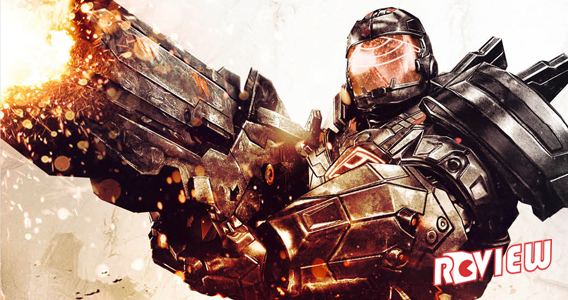
Conduit 2 is a strange, mysterious product—much like the preposterous conspiracy story it attempts to tell. A mix of ideas from other games, painted with a brush of humor and absurdity and featuring a hero who recalls Duke Nukem more so than the grim soldiers of more recent games, it’s software that strains against the limitations of its platform and manages to come out only as satisfying as it is frustrating.
The protagonist is Michael Ford, former secret service agent on a quest to defeat some sort of alien bad guy who’s out to do stuff, I guess. I can’t tell you much more than that, because the game didn’t see fit to tell me much more than that. The story provides no context for the events, which I imagine is fine if you played the previous game—but I did not. I suppose I now understand how new players feel when picking up Halo 2 or 3.
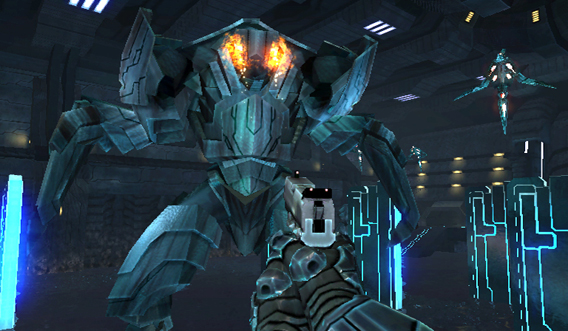
This is symptomatic of a larger problem, however, which is the way the game communicates with the player—or rather, that it often doesn’t. The player is simply never educated on the premise or mechanics of the game, nor many of the core features.
There is an upgrade system—but the player is never told how to use it, how to collect upgrades, or, indeed, that it even exists. The campaign can be expanded by unlocking secret missions that can yield new weapons and items—but, again, the player is never informed that the opportunity exists.
While I understand the desire to leave some things hidden for the player to discover through exploration, Conduit 2 is in absolutely dire need of a tutorial to educate on the matter of its core gameplay features.
With regards to that gameplay, Conduit 2 is a reasonable collection of shooter conventions, with a little Call of Duty here, a little Metroid there, and a lot of Halo over here. Combat feels very much inspired by the latter game, while the All-Seeing-Eye device recalls Metroid’s various visor modes. The game doesn’t really elevate or interpret these borrowed ideas in new ways, but it does use them capably. The result is that the core gameplay is satisfying, even if opportunities were missed in the expansion and interplay that could have existed between these mechanics.
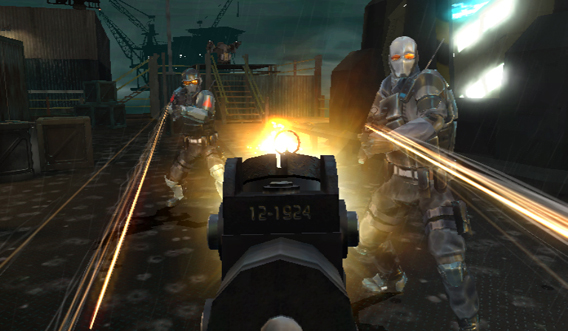
Control with the Wii remote is something of a mixed bag. Default settings for sensitivity and the bounding box are acceptable, but imperfect; I often found myself waving my reticule around to adjust my direction, and the sensitivity was high enough to cause my aim to bob awkwardly. That said, careful aim is rewarded with exceptional precision.
Additionally, there’s a lot of functionality that has been implemented here, but unfortunately the design of the Wii remote simply isn’t very accommodating. The remote, with its awkwardly positioned buttons, required me to constantly adjust my grip to take advantage of the various features.
If you’ve had this experience before, you know that grip adjustment is something that should not factor into any experience; it immediately hampers gameplay and pulls you out of the games. This is especially damning in combat, where having to adjust grip to hit reload and then adjust again to aim down the sights is plainly a disaster.
However, I can hardly blame the game for the shortcomings of Nintendo’s “Designed for Party Games” controller—and fortunately, Conduit 2 mitigates its awkward control by offering a suite of customization options. In addition to the ability to customize the button layout, the Wii remote sensitivity and the bounding box that dictates at which point the character begins to turn can also be adjusted to player preference. Also supported is Wii Motion Plus, alongside the classic controllers for those who want even more options, though I stuck to the standard remote for this review.
I found that, upon making the bounding box as small as possible I was much more comfortable, with my movement and aim far more precise. However, there was a significant drawback: because the bounding box not only affects normal aiming, but also the scoped or aim-down-the-sights reticule, reducing the size of the box made scoped weapons and ADS useless, with these functions becoming wildly oversensitive.
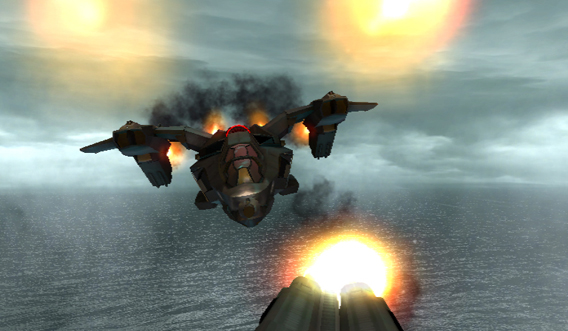
While I commend High Voltage for offering a range of control customization options, this oversight significantly hampers their usefulness; I was ultimately forced to choose between comfortable hip-fire and turning or functional scopes and ADS.
Also problematic is the relation between the position of the reticule while aiming down the sights to the position of the hip fire reticule. Initiating ADS will result in a reticule position that is roughly (or exactly) where the player wants it, but the player’s view is reoriented drastically when leaving ADS to account for the new position of the remote relative to the screen. This change is a little disorienting and extremely inconvenient, serving to make combat slower and more awkward.
That said, the dreadfully moronic AI will rarely take advantage of any momentary vulnerability. All things considered, there are really only three types of enemies to encounter, as identified by their behaviours:
1. The kind that stand in the open and shoot you.
2. The kind that march directly towards you and shoot you.
3. The kind that run up and bite your ankles.
With the exception of boss battles and a single on-rails vehicle sequence, these are the enemy types the player fights for the entirety of the experience. The ankle-biters are frustrating, as Wii control simply doesn’t work well in close quarters, while the other enemy types just aren’t particularly engaging to combat. They have limited behaviors and use them sparingly, they don’t animate well, and they’re slow-witted—which might make the campaign unbearably easy and slow-paced if there weren’t so many of them.
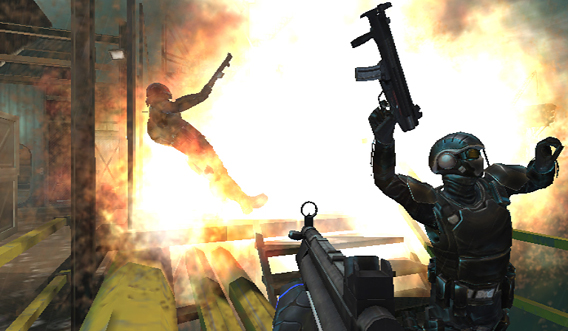
Fortunately, the game manages to redeem the core gameplay with a strong selection of weapons and satisfying shooting. There’s a selection of standard shooter pistols, assault rifles, and SMG’s—and then there’s the more eclectic sci-fi weaponry. These range from bizarre, organic weapons (including a creature that has the player’s hand crammed up its… well, you know) to heavy-weight, high-tech science-blasters.
Every weapon has a secondary feature which may be as simple as ADS or as absurd as the ability to launch a black hole. Some of these features are more for novelty than combat efficacy, but they’re always interesting—and a welcome departure from the bland norm that has overtaken mainstream shooter weapons. If you’re looking for relief from the endless parade of assault rifles, Conduit 2 won’t disappoint.
Level design is another high point; each distinct location looks entirely different from the others, right down to the doorways. There’s almost no recycled design here, and the art design is solid; from jungles to abandoned cities and alien spaceships, the backdrop is always changing and always interesting.
Missions are also comfortable to navigate—save for the occasional awkwardly hidden path—and conceal a pleasant amount of explorability. A wealth of items, log entries, and artifacts are hidden everywhere, extending the life of the otherwise six-hour campaign considerably.
Additionally, all tasks in the campaign (such as unlocking achievements or discovering relics) contribute to the player’s credit count, which can be leveraged to purchase upgrades and weapons. These can be organized into discrete loadouts that can then be equipped in both the campaign and the multiplayer component (with some upgrades being exclusive to one or the other).
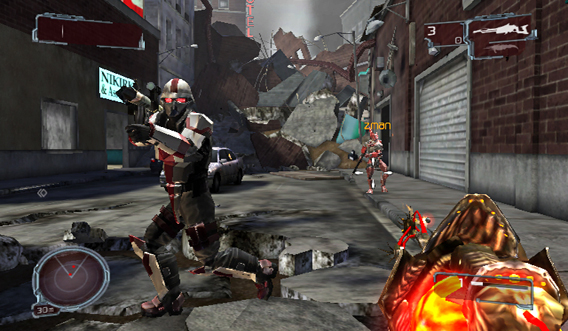
The multiplayer itself is fairly elaborate, featuring the aforementioned expansive catalog of weapons and upgrades, alongside a whole mess of gametypes. There isn’t much here that’s new; like the core game, it’s assembled of pieces taken from other high profile releases (yet another iteration on Call of Duty’s perk system, for example), but what is here is done reasonably well. With the wealth of gametypes and progression options (and the unique weapons that put an interesting spin on things), players who enjoy the core Conduit gameplay experience will find a decent way to drain some hours.
The game is unfortunately hampered by a couple of technical issues, however. Framerate (more in the campaign than the multiplayer) is a serious issue, sometimes dipping to unacceptably low levels. While Conduit 2 is fairly graphically impressive for a Wii title, it’s not so high-powered as to warrant these framerate dips, which impede an otherwise solid graphical offering.
Also on the technical side, the first mission includes a possible glitch that, if encountered, will force players to restart the campaign.
The paramount problem with Conduit 2, though, isn’t technical shortcomings. The real problem is that it’s actually a good game—but you have to force it. That’s not something players should have to contend with; they shouldn’t have to dabble endlessly in menus to pound out a control mechanic that works, and they shouldn’t have to surmount poor instruction and communication of the game’s core features.
The result is a product that will satisfy anyone starving for a solid Wii shooter, but won’t ingratiate itself to players who are accustomed to the catalog available on other consoles.
High Voltage Studios
Publisher
Sega
System
Nintendo Wii
Modes
Singleplayer, Splitscreen and Online Multiplayer
Release Date
April 19, 2011
*A copy of this title was provided by the publisher for review

Well, I am glad to hear that Classic Controller is supported… something that Metroid Prime 3 & Metroid 1 & 2 remake failed to do, which made all of those games unplayable for me. Damn curse of the South Paw.
Comment by Ujn Hunter — May 3, 2011 @ 1:29 pm
Well, it’s not the Wii’s fault that you’re defective soo…. hahaha. I really liked the first one but all retail purchases are on hold since the $$$ is going into baby expenses with retail games having to wait for gift cards, store credit or december.
Comment by EdEN — May 3, 2011 @ 4:07 pm
I know you’re ‘just joking’ when you say he’s defective for being left-handed, but…
…it’s not funny. It’s just mean.
Comment by Peter Locke — May 5, 2011 @ 5:12 am
Weird; I’m left-handed and I haven’t had a problem with the Wii remote–though I hold it like a right-handed person, as I do all gaming controls.
The only controller I imagine having a problem with is Sony’s blaster peripheral for the move; I’d want to hold that left-handed, which would cause a problem.
Comment by Brad Johnson — May 3, 2011 @ 8:25 pm
Ujn likes to tell us he’s left handed because he wants to feel special… and he secretly loves Nintendo and the Wii but has to complain about it to keep his “cool” factor alive, right Ujn? Hehehe.
Comment by EdEN — May 4, 2011 @ 12:33 am
I can’t hold the Wiimote in my right hand… it feels sooo unnatural to me. :(
Comment by Ujn Hunter — May 4, 2011 @ 2:43 pm